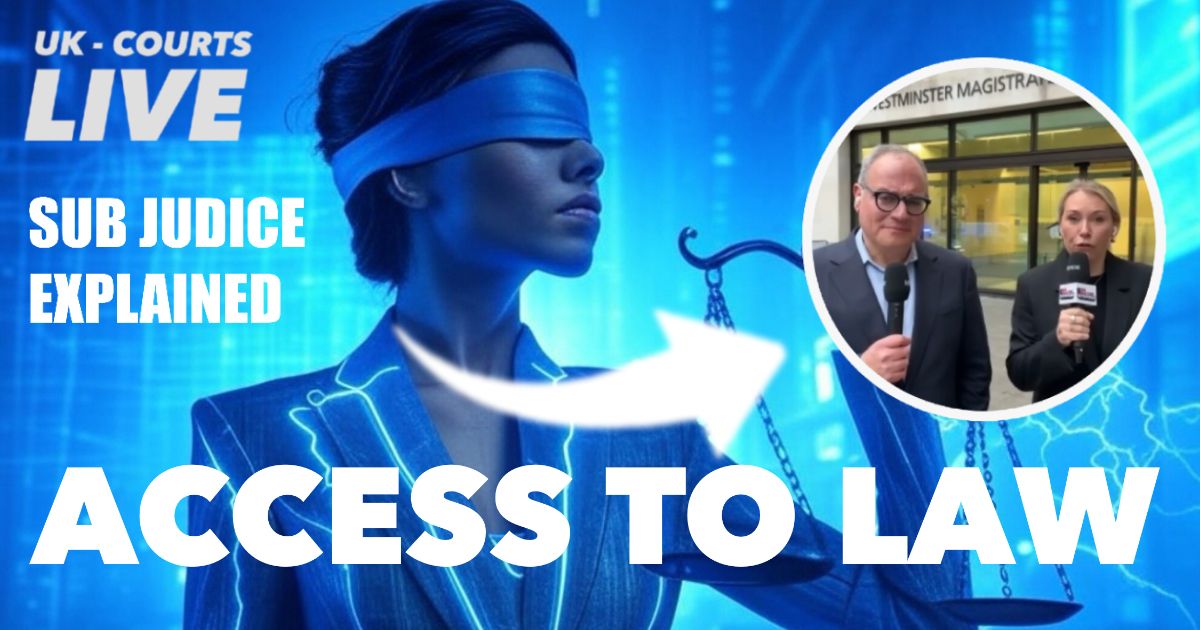Sub Judice Explained Amid Tommy Robinson Trial Tweet Ban Controversy
Shocking courtroom clampdown! Live tweets spark fury as judge halts biased posts in Tommy Robinson’s trial, exposing the tightrope of sub judice in UK courts.
A Westminster Magistrates’ Court judge today banned a number of people from live tweeting from the court during the ongoing Tommy Robinson terrorism trial, sparking a deeply flawed debate over the boundaries of courtroom reporting in non-jury proceedings.
The decision came amid highly contentious real-time updates on the Tommy Robinson terrorism trial where commentary sharply veered into prejudicial territory, prompting the court to enforce restrictions to safeguard the administration of justice.
Legal experts affirm the ruling’s validity under the Contempt of Court Act 1981, which applies universally to active proceedings, irrespective of jury involvement.
District Judge Sam Goozée, presiding over the Tommy Robinson trial acted decisively as updates included accusations of judicial bias, unethical conduct by the prosecutor, systemic “two-tier justice,” & even direct unprofessional name calling of police officers giving evidence, creating a substantial risk of serious prejudice.
Section 2(2) of the 1981 Act deems such publications contemptuous if they impede justice, a threshold met here through editorialising that impugned court officers and the process itself.
Many Critics quickly argued that the ban was unnecessary in a magistrates’ court, citing the absence of a jury susceptible to external influence, yet they totally overlooked the broader risks: eroding public confidence, pressuring witnesses, and undermining impartiality before a district judge trained to disregard extraneous material but operating within a system vulnerable to reputational harm.
Many precedents, such as HM Attorney General v Associated Newspapers Ltd, underscores that contempt protections do extend to non-jury trials where publications threaten the judicial process’s integrity.
The strict liability rule in Section 2(3) targets public-facing content during active cases, amplified by social media’s reach—initial posts in this instance garnered over 120,000 views, heightening potential interference.
Banning these persons from live tweeting was not an overreach but a proportionate measure to prevent ongoing breaches, especially as commentary mocked prosecution arguments as “lame,” labelled judges “political,” and accused officers of falsehoods in real time.
Todays antics highlights the perils of unregulated courtroom broadcasting by untrained individuals, contrasting sharply with the discipline of professional court correspondence.
True live reporting demands adherence to ethical codes from bodies like the Society of Editors and IPSO, balancing public interest with legal constraints under the Contempt Act and court-specific directions.
Skilled correspondents, often legally trained or accredited, filter facts from opinion, avoiding inflammatory language that could sway perceptions or invite Attorney General scrutiny.
Untrained tweeting, by contrast, risks crossing into contempt by prioritising sensationalism over accuracy—offering subjective verdicts on evidence, maligning participants, and blurring reportage with advocacy.
Professionalism requires mastery of sub judice rules, where active proceedings bar prejudicial comment, and an understanding that magistrates’ courts, though bench-led, feed into appeals and public trust in the judiciary.
Without such expertise, reporters expose themselves and publishers to fines, imprisonment, or injunctions, as seen in past cases where biased live streams led to contempt findings.
The negative outcomes of today’s lapses are clear: delayed justice, eroded court authority, and a chilling effect on legitimate media access.
When commentary accuses prosecutors of “scurrilous” motives or implies political vendettas, it not only prejudices the instant trial but fuels misinformation, complicating enforcement of reporting restrictions.
Courts must reiterate that live access is a privilege, granted via judicial approval, revocable when abused—today’s ban serves as a reminder that freedom of expression yields to fair trial rights under Article 6 of the European Convention on Human Rights, as incorporated by the Human Rights Act 1998.
For platforms like UK Courts Live, committed to transparent access to law, this underscores the need for rigorous training in contempt law, ethical reporting, and the inverted pyramid of factual primacy.
Correspondents must lead with verifiable events—the prosecution’s opening, witness testimonies, judicial interventions—eschewing personal barbs that invite sanctions.
Only through disciplined practice can live coverage illuminate justice without distorting it, ensuring the public gains insight rather than prejudice.
As the debate rage, the law remains unequivocal: in any active proceeding, contempt lurks where commentary supplants fact, demanding professionalism to uphold the rule of law.




